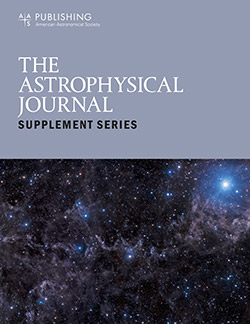AutoTAB: Automatic Tracking Algorithm for Bipolar Magnetic Regions
IF 8.5
1区 物理与天体物理
Q1 ASTRONOMY & ASTROPHYSICS
引用次数: 1
Abstract
Abstract Bipolar magnetic regions (BMRs) provide crucial information about solar magnetism. They exhibit varying morphology and magnetic properties throughout their lifetime, and studying these properties can provide valuable insights into the workings of the solar dynamo. The majority of previous studies have counted every detected BMR as a new one and have not been able to study the full life history of each BMR. To address this issue, we have developed Automatic Tracking Algorithm for BMRs (AutoTAB) that tracks the BMRs for their entire lifetime or throughout their disk passage. AutoTAB uses the binary maps of detected BMRs and their overlapping criterion to automatically track the regions. In this first article of this project, we provide a detailed description of the working of the algorithm and evaluate its strengths and weaknesses by comparing it with existing algorithms. AutoTAB excels in tracking even for the small BMRs (with a flux of ∼10 20 Mx), and it has successfully tracked 9152 BMRs over the last two solar cycles (1996–2020), providing a comprehensive data set that depicts the evolution of various properties for each BMR. The tracked BMRs exhibit the well-known butterfly diagram and 11 yr solar cycle variation, except for small BMRs, which appear at all phases of the solar cycle and show a weak latitudinal dependence. Finally, we discuss the possibility of adapting our algorithm to other data sets and expanding the technique to track other solar features in the future.AutoTAB:双极磁区的自动跟踪算法
双极磁区(BMRs)提供了关于太阳磁性的重要信息。它们在一生中表现出不同的形态和磁性,研究这些特性可以为了解太阳能发电机的工作原理提供有价值的见解。以往的大多数研究将每一个检测到的BMR都算作一个新的BMR,并不能研究每个BMR的完整生活史。为了解决这个问题,我们开发了bmr自动跟踪算法(AutoTAB),可以跟踪bmr的整个生命周期或整个磁盘通道。AutoTAB使用检测到的bmr的二值图和它们的重叠标准来自动跟踪区域。在该项目的第一篇文章中,我们详细描述了该算法的工作原理,并通过将其与现有算法进行比较来评估其优缺点。AutoTAB在跟踪小BMR(通量为~ 10 20 Mx)方面表现出色,并且在过去的两个太阳周期(1996-2020)中成功地跟踪了9152个BMR,提供了一个全面的数据集,描述了每个BMR的各种特性的演变。跟踪的bmr表现出众所周知的蝴蝶图和11年太阳周期变化,除了小bmr,它们出现在太阳周期的所有阶段,并表现出较弱的纬度依赖性。最后,我们讨论了将我们的算法应用于其他数据集的可能性,并在未来扩展该技术以跟踪其他太阳特征。
本文章由计算机程序翻译,如有差异,请以英文原文为准。
求助全文
约1分钟内获得全文
求助全文
来源期刊

Astrophysical Journal Supplement Series
地学天文-天文与天体物理
CiteScore
14.50
自引率
5.70%
发文量
264
审稿时长
2 months
期刊介绍:
The Astrophysical Journal Supplement (ApJS) serves as an open-access journal that publishes significant articles featuring extensive data or calculations in the field of astrophysics. It also facilitates Special Issues, presenting thematically related papers simultaneously in a single volume.
 求助内容:
求助内容: 应助结果提醒方式:
应助结果提醒方式:


